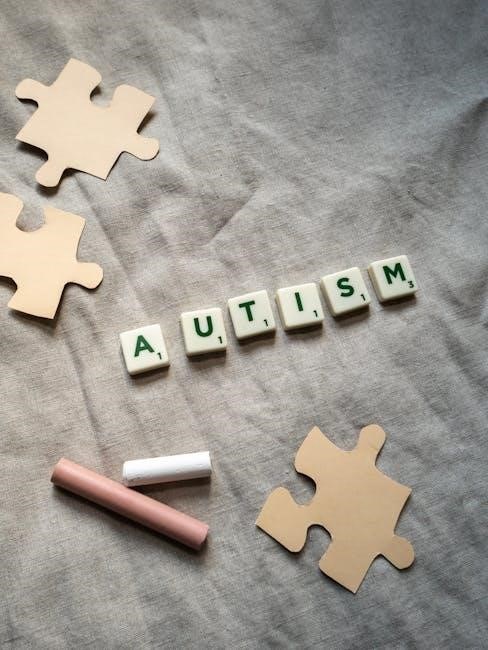
life skills for autism pdf
Life skills are essential for individuals with autism to navigate daily tasks, social interactions, and independence. These skills, such as personal care, communication, and self-advocacy, are vital for building confidence and promoting inclusion in society. By fostering these abilities, individuals with autism can lead fulfilling and self-determined lives. Early intervention and consistent practice are key to developing these critical life skills effectively.
1.1 Understanding the Importance of Life Skills
Life skills are crucial for individuals with autism to achieve independence, social integration, and emotional well-being. These skills enable them to perform daily tasks, communicate effectively, and navigate real-life situations confidently. Without these skills, individuals may struggle with self-care, relationships, and decision-making. Life skills empower autistic individuals to reduce reliance on others, fostering self-reliance and resilience. They also provide a foundation for personal development, helping individuals pursue their goals and aspirations. By prioritizing life skills, parents and caregivers can equip autistic individuals with the tools needed to thrive in various aspects of life, promoting a more fulfilling and independent future.
1.2 Overview of Key Areas for Development
Key areas for development in autism include personal care, social communication, emotional regulation, and daily living skills. These areas focus on building independence, self-awareness, and practical abilities. Personal care involves hygiene and self-management, while social communication enhances interaction and understanding. Emotional regulation helps manage stress and emotions, fostering resilience. Daily living skills, such as household responsibilities and time management, prepare individuals for independence. By addressing these areas, caregivers and educators can create a comprehensive plan to support autistic individuals in achieving their full potential and integrating successfully into society.

Assessment and Identification of Skills
Assessment is crucial for identifying strengths, challenges, and skill gaps in autistic individuals. It helps create personalized strategies to enhance independence and daily functioning effectively.
2.1 Identifying Strengths and Challenges
Identifying strengths and challenges is the foundation of effective skill development for autistic individuals. Assessments help pinpoint areas of aptitude and difficulty, guiding tailored strategies. Parents and caregivers play a crucial role in observing and documenting behaviors, preferences, and learning styles. By understanding individual strengths, such as problem-solving or attention to detail, these can be leveraged to build confidence. Conversely, challenges like sensory sensitivities or communication barriers can be addressed with specific interventions. Visual aids and structured routines often support this process, creating a clear path for growth and adaptation. This step ensures personalized approaches to learning and development.
2.2 Using Assessment Tools and Strategies
Effective assessment tools and strategies are crucial for evaluating the life skills of autistic individuals. Standardized assessments, checklists, and observation logs help identify skill levels and track progress. Informal methods, such as parent and caregiver feedback, provide valuable insights into daily behaviors and needs. Visual aids like charts and schedules can support assessment processes, ensuring clarity and consistency. These tools help create personalized plans tailored to the individual’s requirements. Regular reassessment ensures strategies remain relevant and effective, fostering continuous growth and adaptation. By leveraging these resources, caregivers can better understand and address the unique needs of autistic individuals, promoting meaningful development. Early and consistent use of these tools enhances outcomes significantly.
Teaching Life Skills at Home
Teaching life skills at home involves creating a supportive environment where autistic individuals can practice daily tasks. Parents and caregivers play a vital role in fostering independence by breaking skills into manageable steps and using visual aids to reinforce learning. Structured routines and consistent practice help build confidence and mastery of essential life skills, preparing individuals for greater independence in their daily lives and future endeavors.
3.1 Creating a Supportive Learning Environment
Creating a supportive learning environment at home is crucial for teaching life skills to autistic individuals. A calm, organized space with minimal distractions helps focus attention and reduces anxiety. Visual aids like schedules and checklists provide structure and clarity, making tasks more manageable. Incorporating the individual’s interests and preferences can increase motivation and engagement. Consistent routines and positive reinforcement, such as praise or rewards, encourage progress and build confidence. By tailoring the environment to meet unique needs, parents and caregivers can foster a positive and effective learning experience that promotes skill development and independence.
3.2 Using Visual Aids and Structured Routines
Visual aids and structured routines are powerful tools for teaching life skills to autistic individuals. Visual schedules and checklists provide clear expectations, reducing anxiety and improving task completion. Social stories and communication boards help clarify social cues and behaviors. Structured routines create predictability, which can enhance focus and reduce sensory overload. By incorporating these strategies, caregivers can break down complex tasks into manageable steps, fostering independence and confidence. Consistency and visual reinforcement are key to helping individuals with autism thrive in both home and community settings.
Daily Living Skills
Daily living skills are essential for independence, including personal care, hygiene, and household tasks. Structured routines and visual supports help individuals with autism master these practical abilities effectively.
4.1 Personal Care and Hygiene
Personal care and hygiene are fundamental life skills for individuals with autism, promoting health and independence. These skills include bathing, brushing teeth, and using the bathroom. Consistency and positive reinforcement are key. Visual aids like schedules or charts can help individuals remember daily routines. Breaking tasks into small, manageable steps reduces anxiety. For example, teaching handwashing by demonstrating each step; Encouraging self-monitoring, like checking if teeth are clean, fosters responsibility. Sensory-friendly products, such as gentle soaps, can make these tasks more comfortable. Mastering personal care builds confidence and prepares individuals for greater independence in daily living.
4.2 Household Responsibilities and Time Management
Teaching household responsibilities and time management is crucial for independence; Start with simple tasks like tidying up or setting the table. Use visual aids like charts or schedules to create routines. Break tasks into smaller, manageable steps to reduce overwhelm. For example, laundry can be divided into sorting, washing, and folding. Time management tools, such as timers or apps, help individuals stay on track. Assigning specific roles fosters a sense of responsibility and contribution to the household. Positive reinforcement and praise encourage consistency and mastery of these essential life skills, promoting independence and self-esteem over time.

Social and Communication Skills
Social and communication skills are vital for building relationships and interacting effectively. Techniques like role-playing and visual aids help individuals with autism navigate conversations and understand nonverbal cues, fostering connections and confidence.
5.1 Initiating and Maintaining Conversations
Initiating and maintaining conversations is a crucial social skill for individuals with autism. It involves understanding cues, expressing thoughts clearly, and engaging in reciprocal dialogue. Visual aids, role-playing, and structured routines can help build confidence and reduce anxiety. Practicing active listening and using prompts can encourage participation. Gradual exposure to real-life conversations, paired with positive reinforcement, fosters improvement. Teaching strategies like asking open-ended questions and recognizing emotional tones enhances communication. These skills are foundational for forming meaningful relationships and navigating social environments effectively. Consistent practice and tailored support are key to fostering strong conversational abilities.
5.2 Understanding and Using Nonverbal Cues
Understanding nonverbal cues, such as facial expressions, gestures, and body language, is vital for effective communication. Many individuals with autism may find interpreting these cues challenging, which can impact social interactions. Teaching strategies like recognizing emotional expressions through photos or videos can improve awareness. Role-playing activities and visual aids, such as social stories, can help individuals learn and practice appropriate responses. Encouraging observation of nonverbal signals in real-life situations fosters practical application. Mastery of these skills enhances emotional intelligence and the ability to navigate complex social environments with greater confidence and understanding.
Emotional Regulation and Coping Mechanisms
Emotional regulation is crucial for managing stress and anxiety in individuals with autism. Techniques like deep breathing, visualization, and physical activity help calm emotions. Identifying triggers and using coping strategies, such as sensory tools or mindfulness practices, fosters self-awareness and control. Teaching self-monitoring skills and providing emotional support enables individuals to handle challenges effectively, promoting emotional well-being and resilience in daily life.
6.1 Developing Emotional Awareness
Developing emotional awareness is fundamental for individuals with autism to recognize, understand, and manage their emotions. This involves identifying personal triggers, learning to express feelings appropriately, and understanding others’ emotions. Tools like emotional check-in sessions, visual aids, and social stories can help individuals develop self-awareness. By fostering a supportive environment, caregivers and educators can encourage open communication, allowing individuals to explore and articulate their emotional experiences. This foundation is essential for building healthy emotional regulation and fostering positive interactions in daily life, ultimately enhancing overall well-being and resilience.
6.2 Implementing Stress Management Techniques
Implementing stress management techniques is crucial for individuals with autism to cope with overwhelming situations. Strategies like deep breathing, visualization, and sensory integration activities can help reduce anxiety. Creating a coping skills toolbox with personalized techniques, such as fidgets or calming music, provides immediate relief. Visual schedules and predictable routines also minimize unpredictability, a common stressor. Encouraging open communication and teaching problem-solving skills empowers individuals to address challenges effectively. By fostering a supportive environment and modeling healthy coping mechanisms, caregivers can help individuals with autism manage stress and build resilience for life’s uncertainties.

Goal Setting and Transition Planning
Goal setting and transition planning empower individuals with autism to achieve independence. Creating personalized plans helps navigate academic, social, and career milestones, fostering self-advocacy and lifelong success.
7.1 Setting SMART Goals for Personal Development
Setting SMART (Specific, Measurable, Achievable, Relevant, Time-bound) goals is crucial for personal development in individuals with autism. These goals help break down larger objectives into manageable steps, fostering progress and confidence; For example, a SMART goal might involve improving communication skills by engaging in weekly social interactions. This structured approach ensures that goals are clear, trackable, and aligned with individual needs. By focusing on achievable milestones, individuals can celebrate successes and build motivation, leading to greater independence and self-advocacy in their daily lives.
7.2 Creating a Transition Plan for Adulthood
A transition plan for adulthood is tailored to support individuals with autism in achieving independence and self-advocacy. It outlines clear steps for education, employment, independent living, and social relationships. The plan assesses strengths, challenges, and interests to set realistic objectives. Regular assessments and feedback ensure progress toward goals. Support systems, such as mentors or therapists, play a key role in guiding the individual. This structured approach helps build confidence and prepares them for life beyond structured programs, fostering a smooth and empowering transition into adulthood.
Community Integration and Independent Living
Community integration and independent living empower individuals with autism to participate in societal activities and develop self-advocacy. Tailored strategies from toolkits and studies support their seamless integration into society, fostering independence and confidence through structured programs and personalized approaches.
8.1 Participating in Community Activities
Participating in community activities is crucial for individuals with autism to build social connections and independence. Engaging in local clubs, sports, or volunteer work fosters a sense of belonging and reduces isolation. These activities help develop essential life skills, such as communication and teamwork, while exposing individuals to diverse environments. Supportive strategies, like visual aids or gradual exposure, can ease participation. Encouraging involvement in community events promotes confidence and self-advocacy, empowering individuals to thrive in society. Tailored approaches ensure meaningful engagement, aligning with personal interests and abilities to enhance overall well-being and integration into community life effectively;

8.2 Developing Self-Advocacy and Independence
Developing self-advocacy and independence empowers individuals with autism to express their needs and preferences confidently. Teaching self-assessment skills helps them identify strengths and challenges, fostering personal growth. Encouraging decision-making and problem-solving builds resilience. Support systems, like communication aids, enable effective self-expression. Gradual independence in daily tasks promotes confidence and autonomy. Empowering individuals to advocate for themselves ensures they can navigate various environments successfully. This foundation is critical for transitioning into adulthood, where self-reliance and self-advocacy are essential for achieving personal goals and living a fulfilling, independent life.
Leave a Reply
You must be logged in to post a comment.